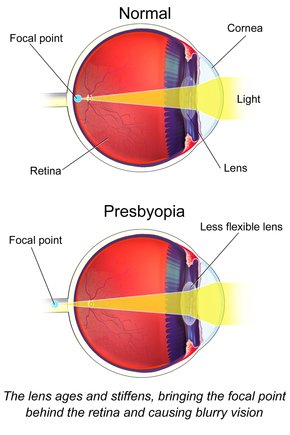Constants a Person Struggles to Read by Holding a Book at Arm's Length, a Distance of 45 Cm Away.
| Presbyopia | |
|---|---|
| Other names | The aging heart status[i] |
  | |
| A person with presbyopia cannot easily read the pocket-sized impress of an ingredients list (summit) compared to someone without presbyopia (lesser). | |
| Specialty | Optometry, ophthalmology |
| Symptoms | Difficulty reading small print, having to hold reading fabric farther away, headaches, eyestrain[ane] |
| Usual onset | Progressively worsening in those over twoscore years former[1] |
| Causes | Crumbling-related hardening of the lens of the eye[one] |
| Diagnostic method | Center test[1] |
| Handling | Eyeglasses,[1] contact lenses[2] |
| Frequency | 25% currently;[3] all eventually affected[1] |
Presbyopia is physiological insufficiency of accommodation associated with the aging of the eye that results in progressively worsening ability to focus clearly on close objects.[four] Also known equally age-related farsightedness[five] (or age-related long sight in the UK[half-dozen]), it affects many adults over the age of 40. A common sign of presbyopia is difficulty reading small impress which results in having to hold reading cloth farther away. Other symptoms associated can exist headaches and eyestrain.[4] Different people volition have different degrees of problems.[1] Other types of refractive errors may exist at the same time as presbyopia.[i] This status is similar to hypermetropia or far-sightedness which starts in childhood and exhibits similar symptoms of blur in the vision for close objects.
Presbyopia is a normal part of the aging process.[4] Information technology occurs due to historic period related changes in lens (decreased elasticity and increased hardness) and ciliary muscle power of the eye, causing the eye to focus light backside rather than on the retina when looking at close objects.[4] It is a blazon of refractive fault along with nearsightedness, farsightedness, and astigmatism.[4] Diagnosis is by an eye examination.[4]
Presbyopia can be corrected using spectacles, contact lenses, multifocal intraocular lenses, or LASIK (presbyLASIK) surgery.[2] [seven] [4] The nearly mutual handling is drinking glass correction using appropriate convex lens. Glasses used to correct presbyopia may be elementary reading glasses, bifocals, trifocals, or progressive lens.[4]
People over xl are at risk for developing presbyopia and all people go affected to some degree.[1] Around 25% of people (1.8 billion globally) are currently affected.[3]
Signs and symptoms [edit]
The starting time symptoms most people notice are difficulty reading fine print, especially in low light conditions, eyestrain when reading for long periods, blurring of near objects or temporarily blurred vision when changing the viewing distance. Many farthermost presbyopes complain that their arms have become "too short" to hold reading material at a comfortable distance.
Presbyopia, like other focal imperfections, becomes less noticeable in bright sunlight when the student becomes smaller.[8] Every bit with whatsoever lens, increasing the focal ratio of the lens increases depth of field by reducing the level of mistiness of out-of-focus objects (compare the effect of discontinuity on depth of field in photography).
The onset of presbyopia varies among those with certain professions and those with miotic pupils.[ix] In particular, farmers and homemakers seek correction later, whereas service workers and construction workers seek correction earlier. Scuba divers with involvement in underwater photography may notice presbyopic changes while diving before they recognize the symptoms in their normal routines due to the near focus in low low-cal conditions.[10]
Interaction with myopia [edit]
People with low nearly-sightedness can read comfortably without eyeglasses or contact lenses even later age forty, only higher myopes might require two pairs of glasses (one for distance, one for near), bifocal, or progressive lenses. However, their myopia does not disappear and the long-distance visual challenges remain. Myopes considering refractive surgery are advised that surgically correcting their nearsightedness may be a disadvantage after age forty, when the optics go presbyopic and lose their ability to arrange or change focus, because they volition then need to use glasses for reading. Myopes with low astigmatism find near vision improve, though not perfect, without glasses or contact lenses when presbyopia sets in, just the more astigmatism, the poorer the uncorrected nearly vision.
A surgical technique offered is to create a "reading eye" and a "altitude vision eye", a technique commonly used in contact lens practice, known as monovision. Monovision tin can be created with contact lenses, so candidates for this procedure can determine if they are prepared to have their corneas reshaped past surgery to cause this effect permanently.
Mechanism [edit]

The cause of presbyopia is lens hardening past decreasing levels of α-crystallin, a procedure which may be sped upwardly by higher temperatures.[11] It results in a almost point greater than 25 cm[12] (or equivalently, less than 4 diopters).
In optics, the closest point at which an object tin can be brought into focus by the eye is called the eye'due south near signal. A standard about point distance of 25 cm is typically assumed in the design of optical instruments, and in characterizing optical devices such as magnifying glasses.
There is some confusion over how the focusing mechanism of the middle works.[ clarification needed ] In the 1977 book, Middle and Encephalon,[xiii] for example, the lens is said to be suspended by a membrane, the 'zonula', which holds information technology under tension. The tension is released, by contraction of the ciliary musculus, to allow the lens to get more round, for close vision. This implies the ciliary muscle, which is outside the zonula, must be circumferential, contracting similar a sphincter, to slacken the tension of the zonula pulling outwards on the lens. This is consequent with the fact that our eyes seem to be in the 'relaxed' state when focusing at infinity, and as well explains why no amount of effort seems to enable a myopic person to meet farther abroad.
The ability to focus on most objects declines throughout life, from an accommodation of nearly xx dioptres (ability to focus at 50 mm away) in a child, to ten dioptres at age 25 (100 mm), and levels off at 0.five to 1 dioptre at age 60 (power to focus downwards to 1–2 meters just). The expected, maximum, and minimum amplitudes of accommodation in diopters (D) for a corrected patient of a given age can be estimated using Hofstetter'south formulas: expected amplitude (D) = 18.5 - 0.3 × (age in years), maximum amplitude (D) = 25 - 0.iv × (age in years), minimum amplitude (D) = xv - 0.25 × (historic period in years).[14]
Treatment [edit]
In the visual system, images captured by the eye are translated into electric signals that are transmitted to the brain where they are interpreted. As such, in order to overcome presbyopia, two master components of the visual system can exist addressed: image capturing by the optical system of the eye and image processing in the brain.
Image capturing in the eye [edit]
Solutions for presbyopia accept avant-garde significantly in recent years due to widened availability of optometry care and over-the-counter vision correction options.
Corrective lenses [edit]
Corrective lenses provide vision correction over a range every bit high as +iv.0 diopters. People with presbyopia require a convex lens for reading spectacles; specialized preparations of convex lenses normally require the services of an optometrist.[15]
Contact lenses can also exist used to correct the focusing loss that comes forth with presbyopia. Multifocal contact lenses tin be used to correct vision for both the near and the far. Some people cull contact lenses to correct one centre for virtually and one heart for far with a method called monovision.
Surgery [edit]
Refractive surgery has been done to create multifocal corneas.[16] PresbyLASIK, a type of multifocal corneal ablation LASIK procedure may exist used to correct presbyopia. Results are, however, more variable and some people have a subtract in visual vigil.[17] Concerns with refractive surgeries for presbyopia include people'due south eyes irresolute with fourth dimension too.[16] Other side furnishings of multifocal corneal ablation include postoperative glare, halos, ghost images, and monocular diplopia.[18]
Paradigm processing in the encephalon [edit]
A number of studies have claimed improvements in near visual acuity by the employ of training protocols based on perceptual learning and requiring the detection of briefly presented low-contrast Gabor stimuli; report participants suffering from presbyopia were enabled to read smaller font sizes and to increase their reading speed.[19] [xx] [21] [22]
Eye drops [edit]
Pilocarpine, eye drops that constrict the pupil, has been approved by the FDA for presbyopia.[23] Enquiry on other drugs is in progress.[24] Centre drops intended to restore lens elasticity are also being investigated.[25]
Etymology [edit]
The term is from Greek πρέσβυς presbys meaning "old" and ὤψ ōps meaning "sight" (GEN ὠπός ōpos)[26] [27]).
History [edit]
The condition was mentioned as early as the writings of Aristotle in the 4th century BC.[28] Glass lenses offset came into apply for the trouble in the late 13th century.[28]
See likewise [edit]
- Vuity
References [edit]
- ^ a b c d e f g h i j "Facts About Presbyopia". NEI. October 2010. Archived from the original on iv Oct 2016. Retrieved 11 September 2016.
- ^ a b Pérez-Prados, Roque; Piñero, David P; Pérez-Cambrodí, Rafael J; Madrid-Costa, David (March 2017). "Soft multifocal simultaneous image contact lenses: a review". Clinical and Experimental Optometry. 100 (2): 107–127. doi:10.1111/cxo.12488. PMID 27800638. S2CID 205049139.
- ^ a b Fricke, Timothy R.; Tahhan, Nina; Resnikoff, Serge; Papas, Eric; Burnett, Anthea; Ho, Suit May; Naduvilath, Thomas; Naidoo, Kovin South. (October 2018). "Global Prevalence of Presbyopia and Vision Harm from Uncorrected Presbyopia". Ophthalmology. 125 (10): 1492–1499. doi:10.1016/j.ophtha.2018.04.013. PMID 29753495.
- ^ a b c d e f g h Khurana, AK (September 2008). "Asthenopia, anomalies of accommodation and convergence". Theory and practice of optics and refraction (second ed.). Elsevier. pp. 100–107. ISBN978-81-312-1132-8.
- ^ "5 Facts Most Age-Related Farsightedness You Probably Didn't Know". www.webmd.com . Retrieved 2 February 2022.
- ^ "Age-related Long Sight". patient.info . Retrieved 2 February 2022.
- ^ "PresbyLASIK - EyeWiki". eyewiki.aao.org . Retrieved 27 August 2020.
- ^ "Presbyopia: Patient Information". Marquette, MI: Eye Assembly of Marquette. 2008. Archived from the original on 2 December 2008. Retrieved 31 October 2010.
- ^ García Serrano, JL; López Raya, R; Mylonopoulos Caripidis, T (Nov 2002). "Variables related to the start presbyopia correction" (Complimentary full text). Archivos de la Sociedad Española de Oftalmología. 77 (xi): 597–604. ISSN 0365-6691. PMID 12410405. Archived from the original on 7 October 2011.
- ^ Bennett QM (June 2008). "New thoughts on the correction of presbyopia for divers". Diving Hyperb Med. 38 (2): 163–164. PMID 22692711. Archived from the original on nineteen April 2013. Retrieved 19 Apr 2013.
- ^ Pathai, S; Shiels, PG; Lawn, SD; Cook, C; Gilbert, C (March 2013). "The eye as a model of ageing in translational research--molecular, epigenetic and clinical aspects". Ageing Enquiry Reviews. 12 (2): 490–508. doi:x.1016/j.arr.2012.xi.002. PMID 23274270. S2CID 26015190.
- ^ Katz, Debora One thousand. (2015). Physics for Scientists and Engineers: Foundations and Connections, Advance Edition. Cengage Learning. ISBN978-one-305-53720-0.
- ^ Gregory, Richard Langton (1977). Eye and encephalon : the psychology of seeing (3rd ed. rev. and update. ed.). New York; Toronto: McGraw-Hill. ISBN978-0070246652.
- ^ Robert P. Rutstein, Kent M. Daum, Anomalies of Binocular Vision: Diagnosis & Management, Mosby, 1998.
- ^ Li, G; Mathine, DL; Valley, P; Ayräs, P; Haddock, JN; Giridhar, MS; Williby, G; Schwiegerling, J; et al. (April 2006). "Switchable electro-optic diffractive lens with loftier efficiency for ophthalmic applications". Proceedings of the National Academy of Sciences of the United states of America. 103 (16): 6100–4. Bibcode:2006PNAS..103.6100L. doi:10.1073/pnas.0600850103. ISSN 0027-8424. PMC1458838. PMID 16597675.
- ^ a b Kim, Tae-im; del Barrio, Jorge 50 Alió; Wilkins, Mark; Cochener, Beatrice; Ang, Marcus (May 2019). "Refractive surgery". The Lancet. 393 (10185): 2085–2098. doi:10.1016/S0140-6736(18)33209-4. PMID 31106754. S2CID 4474834.
- ^ Pallikaris IG, Panagopoulou SI (July 2015). "PresbyLASIK approach for the correction of presbyopia". Current Opinion in Ophthalmology. 26 (4): 265–72. doi:10.1097/icu.0000000000000162. PMID 26058023. S2CID 35434343.
- ^ Dimitri T., Azar (2007). "Terminology, classification, and history of refractive surgery". Refractive surgery (2nd ed.). Philadelphia: Mosby / Elsevier. ISBN978-0-323-03599-6. OCLC 853286620.
- ^ Lev Grand, Ludwig K, Gilaie-Dotan S, et al. (28 November 2014). "Preparation improves visual processing speed and generalizes to untrained functions". Scientific Reports. 4 (ane): 7251. Bibcode:2014NatSR...4E7251L. doi:10.1038/srep07251. PMC4246693. PMID 25431233.
- ^ Polat U., Schor C., Tong J., Zomet A., Lev M., Yehezkel O., Sterkin A., Levi D.M. (23 Feb 2012). "Preparation the brain to overcome the effect of aging on the man eye". Scientific Reports. 2: 278. Bibcode:2012NatSR...2E.278P. doi:ten.1038/srep00278. PMC3284862. PMID 22363834.
{{cite periodical}}: CS1 maint: multiple names: authors list (link) - ^ DeLoss DJ, Watanabe T, Andersen GJ (2014). "Optimization of perceptual learning: Furnishings of task difficulty and external dissonance in older adults". Vision Research. 99: 37–45. doi:ten.1016/j.visres.2013.xi.003. PMC4029927. PMID 24269381.
- ^ Sterkin A, Levy Y, Pokroy R, Lev Chiliad, Levian L, Doron R, Yehezkel O, Fried Thou, Frenkel-Nir Y, Gordon B, Polat U (2018). "Vision improvement in pilots with presbyopia following perceptual learning". Vision Research. 152 (152): 61–73. doi:ten.1016/j.visres.2017.09.003. PMID 29154795. S2CID 20260936.
- ^ Moyer, Melinda Wenner (fourteen December 2021). "New Eye Drops Offer an Alternative to Reading Glasses". The New York Times. ISSN 0362-4331. Retrieved xv December 2021.
- ^ Dick, HB (July 2019). "Small-aperture strategies for the correction of presbyopia". Current Opinion in Ophthalmology. 30 (4): 236–242. doi:x.1097/ICU.0000000000000576. PMID 31033734. S2CID 139101960.
- ^ Korenfeld, Michael S.; Robertson, Stella M.; Stein, Jerry Thou.; Evans, David G.; Rauchman, Steven H.; Sall, Kenneth N.; Venkataraman, Subha; Chen, Bee-Lian; Wuttke, Mark; Burns, William (29 January 2021). "Topical lipoic acrid choline ester eye drop for improvement of near visual acuity in subjects with presbyopia: a safety and preliminary efficacy trial". Eye. 35 (12): 3292–3301. doi:10.1038/s41433-020-01391-z. PMC8602643. PMID 33514891.
- ^ "Presbyopia". Dictionary.reference.com. Archived from the original on 12 April 2013. Retrieved 19 April 2013.
- ^ "Presbyopia". Etymonline.com. Archived from the original on 18 August 2017. Retrieved 4 May 2017.
- ^ a b Wade, Nicholas J.; Wade, Nicholas (2000). A Natural History of Vision. MIT Printing. p. 50. ISBN9780262731294. Archived from the original on 8 September 2017.
External links [edit]
| | Look upwards presbyopia in Wiktionary, the complimentary dictionary. |
- "Presbyopia" at MedLinePlus Medical Encyclopedia
Source: https://en.wikipedia.org/wiki/Presbyopia
0 Response to "Constants a Person Struggles to Read by Holding a Book at Arm's Length, a Distance of 45 Cm Away."
Enviar um comentário